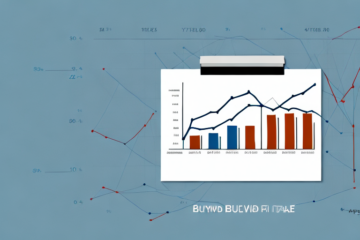Understanding the 1040EZ Form: A Guide to Common Finance Terms
Filing taxes can be a daunting task, but the 1040EZ Form streamlines the process for those with straightforward finances. Here’s everything you need to know to fill out the form correctly and maximize your tax refund.
What is the 1040EZ Form?
The 1040EZ Form is the simplest tax form the Internal Revenue Service (IRS) offers. It’s a one-page form used by individuals who have no dependents, earn less than $100,000/year, and have no itemized deductions. Compared to the more complex Forms 1040 and 1040A, the 1040EZ Form is less time-consuming and easier to fill out.
It’s important to note that not everyone is eligible to use the 1040EZ Form. For example, if you received income from self-employment, rental properties, or gambling winnings, you cannot use this form. Additionally, if you received income from dividends or capital gains, you may not be eligible to use the 1040EZ Form. It’s always a good idea to consult with a tax professional or use tax software to determine which form is best for your specific tax situation.
Who can use the 1040EZ Form?
Not everyone qualifies to use the 1040EZ Form. You can use this form if you:
- Are single or married filing jointly
- Have no dependents
- Are younger than 65 years old
- Are not blind
- Earn only wages, salaries, tips, and taxable scholarship or fellowship grants
- Have earned income of $100,000 or less
- Do not take any deductions other than the standard deduction
It is important to note that if you have any income from self-employment, rental properties, or capital gains, you cannot use the 1040EZ Form. Additionally, if you received any advance payments of the premium tax credit or owe household employment taxes, you are not eligible to use this form. In these cases, you will need to use the 1040 or 1040A Form instead.
What are the requirements for using the 1040EZ Form?
You will need to gather the following information before filling out the 1040EZ Form:
- Your Social Security number (SSN)
- Your spouse’s SSN if married filing jointly
- Your employer’s name, address, and W-2 form
- Your total income amount for the tax year
- Your checking or savings account information if you prefer direct deposit
In addition to the above requirements, you must also meet certain eligibility criteria to use the 1040EZ Form. You can only use this form if you have a taxable income of less than $100,000, do not have any dependents, and are filing as single or married filing jointly. If you have any other types of income, such as self-employment income or income from rental properties, you will need to use a different form.
How to fill out the 1040EZ Form step by step
Here is a brief overview of the filling process:
- Fill in your personal information in the top section of the form.
- Report your income and enter your total income on line 1.
- Choose the standard deduction amount and enter it on line 5.
- Calculate your taxable income by subtracting line 5 from line 1. Enter the amount on line 6.
- Calculate your tax liability by looking up your taxable income on the tax table in the instructions. Enter the amount on line 10.
- Enter any payments or credits you received on lines 7-9.
- Calculate your refund or balance due by subtracting line 10 from line 9. Enter the amount on line 11.
- Sign and date the form at the bottom.
It is important to note that the 1040EZ form can only be used by taxpayers who meet certain criteria, such as having a taxable income of less than $100,000 and not claiming any dependents. If you do not meet these criteria, you will need to use a different form, such as the 1040 or 1040A. Additionally, it is recommended that you double-check all of your calculations and information before submitting the form to avoid any errors or delays in processing.
What are common finance terms used in the 1040EZ Form?
Before filling out the form, it’s essential to understand the following terms:
- Taxable income
- Standard deduction
- Tax credits
- Tax deductions
- Tax liability
- Tax table
- Federal and state taxes
It’s important to note that taxable income refers to the amount of income that is subject to taxation. This includes wages, salaries, tips, and any other income received throughout the year. Standard deduction, on the other hand, is a fixed amount that reduces your taxable income. Tax credits are also important to understand, as they directly reduce the amount of tax you owe. Examples of tax credits include the Earned Income Tax Credit and the Child Tax Credit.
Additionally, tax deductions are expenses that can be subtracted from your taxable income, reducing the amount of tax you owe. Examples of tax deductions include charitable donations and mortgage interest. Tax liability refers to the total amount of tax you owe to the government, while the tax table is a chart used to determine your tax liability based on your taxable income and filing status. Finally, it’s important to understand the difference between federal and state taxes, as both may be owed depending on your income and location.
What is taxable income and how is it calculated?
Taxable income is the amount of income subject to income taxes. It is calculated by subtracting any tax deductions from your total income. Taxable income is what you use to determine your tax liability.
Some common tax deductions that can be subtracted from your total income to calculate your taxable income include contributions to retirement accounts, mortgage interest, and charitable donations. It is important to keep track of these deductions throughout the year to ensure that you are accurately calculating your taxable income and not overpaying on your taxes.
What are tax deductions and how do they work?
Tax deductions are expenses that reduce your taxable income. They can be things like student loan interest paid, IRA contributions, and charitable donations. By taking a deduction, you can reduce your taxable income and your tax liability.
It’s important to note that not all expenses can be deducted from your taxes. Only certain expenses that are considered “allowable deductions” by the IRS can be used to reduce your taxable income. Additionally, there are different types of deductions, such as standard deductions and itemized deductions, which have different requirements and limitations. It’s important to consult with a tax professional or use tax software to ensure you are taking advantage of all the deductions you are eligible for.
What are tax credits and how do they affect your taxes?
Tax credits are dollar-for-dollar reductions in your tax liability. They are more valuable than deductions because they directly reduce the amount of tax you owe. Tax credits include things like the Earned Income Tax Credit and the Child Tax Credit.
It’s important to note that not all tax credits are refundable. Refundable tax credits can result in a refund even if the credit exceeds the amount of taxes owed. Non-refundable tax credits, on the other hand, can only reduce your tax liability to zero. Any excess credit is lost and cannot be refunded. It’s important to understand the difference between refundable and non-refundable tax credits when filing your taxes.
Understanding the difference between federal and state taxes
When you fill out the 1040EZ Form, you will be calculating your federal income tax liability. However, most states also have income taxes that you may need to pay. It’s important to understand the tax laws in your state and determine whether you need to file a state tax return as well.
One key difference between federal and state taxes is that federal taxes are collected by the Internal Revenue Service (IRS), while state taxes are collected by each individual state’s revenue department. This means that the rules and regulations for federal and state taxes can vary widely, and it’s important to stay up-to-date on any changes that may affect your tax liability.
Another important factor to consider when it comes to federal and state taxes is the deductions and credits that are available. While some deductions and credits may apply to both federal and state taxes, others may only be available at the state level. For example, some states offer tax credits for certain types of energy-efficient home improvements, while others may offer deductions for contributions to state-sponsored college savings plans.
Tips for maximizing your tax refund with the 1040EZ Form
To maximize your tax refund with the 1040EZ Form, consider the following tips:
- Claim all tax credits and deductions you are eligible for.
- File your taxes electronically using tax software or a tax professional.
- Double-check your work for errors before submitting your tax return.
- Consider depositing your refund directly into your bank account to receive it faster.
Another tip for maximizing your tax refund with the 1040EZ Form is to file your taxes early. By filing early, you can avoid the last-minute rush and potential errors that can occur when you are in a hurry. Additionally, filing early can help you get your refund faster, as the IRS processes early filers’ returns first.
It is also important to keep accurate records of your income and expenses throughout the year. This can help you identify all the deductions and credits you are eligible for when it comes time to file your taxes. Keeping organized records can also make the tax filing process easier and less stressful.
Common mistakes to avoid when filling out the 1040EZ Form
To avoid making mistakes on the 1040EZ Form, watch out for the following:
- Entering incorrect Social Security numbers or names.
- Forgetting to sign and date the form.
- Using the wrong tax table to calculate your tax liability.
- Miscalculating your taxable income by not taking all tax deductions you are eligible for.
Another common mistake to avoid when filling out the 1040EZ Form is failing to report all of your income. This includes income from freelance work, rental properties, and investments. Make sure to gather all necessary documents and accurately report all sources of income to avoid penalties and potential audits.
How to file your taxes electronically using the 1040EZ Form
To file your taxes electronically using the 1040EZ Form, you can use one of many tax software options. These programs guide you through the steps of filling out the form and can help you identify tax credits and deductions you may have missed. When filing electronically, you will receive your refund quicker than if you filed a paper return.
Another advantage of filing your taxes electronically is that it reduces the risk of errors. The software will automatically check for mistakes and prompt you to correct them before submitting your return. This can save you time and money in the long run, as errors on your tax return can result in penalties and interest charges.
It’s important to note that not everyone is eligible to file using the 1040EZ Form. This form is only for individuals who have a simple tax situation, such as those who have no dependents, earn less than $100,000 per year, and only have income from wages, salaries, tips, and unemployment compensation. If you have a more complex tax situation, you may need to use a different form or seek the assistance of a tax professional.
Frequently asked questions about the 1040EZ Form
Q: What if I make a mistake on my 1040EZ Form?
A: You can file an amended tax return to correct any errors you made on your original tax return. However, you should only do this if you made a significant mistake that affects your tax liability.
Q: Can I file the 1040EZ Form if I have dependents?
A: No. If you have dependents, you cannot use the 1040EZ Form. Instead, you must use either Form 1040 or Form 1040A.
Q: What is the deadline for filing the 1040EZ Form?
A: The deadline for filing the 1040EZ Form is the same as the deadline for filing all other tax returns. Generally, the deadline is April 15th of each year. However, if April 15th falls on a weekend or holiday, the deadline is extended to the next business day.
Conclusion: Why understanding common finance terms is essential when filling out the 1040EZ Form
When filling out the 1040EZ Form, it’s crucial to have a firm grasp of common finance terms such as taxable income, tax credits, and tax deductions. This understanding will help you fill out the form accurately and maximize your tax refund. By following the steps and tips outlined in this guide, you’ll be well on your way to successfully filing your taxes with the 1040EZ Form.
However, it’s important to note that the 1040EZ Form may not be the best option for everyone. If you have a more complex financial situation, such as owning a business or multiple sources of income, you may need to use a different form or seek the assistance of a tax professional.
Additionally, understanding finance terms goes beyond just filling out tax forms. It can also help you make informed decisions about your personal finances, such as managing debt, investing, and saving for retirement. By taking the time to educate yourself on these terms, you can set yourself up for financial success in the long run.










